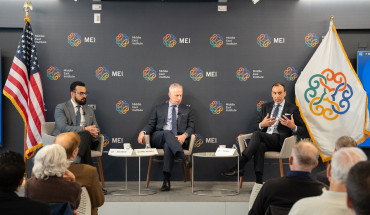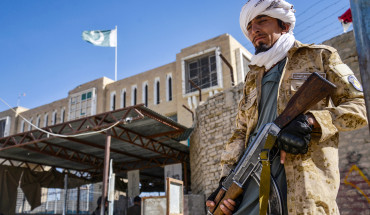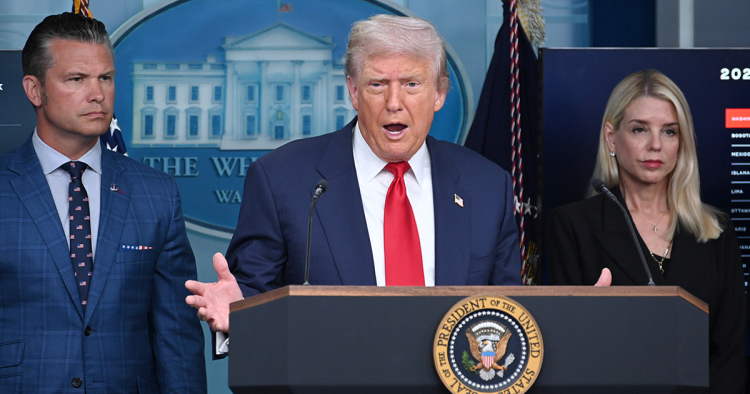All eyes this week are on Alaska, where US President Donald Trump will hold a pivotal meeting with Russian President Vladimir Putin to discuss ending the Ukraine war. But the United States remains consumed by several domestic issues, including continued strains over policing, immigration, and checks and balances inside America’s system of government. All of this comes at a time when Trump’s domestic political standing continues to slip lower, including among members of his own party.
In this swirl of events, several unresolved challenges in the Middle East loom large, foremost among them the ongoing Israel-Hamas war and Israeli Prime Minister Benjamin Netanyahu’s threat this past week to fully reoccupy Gaza.
Ending the Ukraine war moves center stage once again on a packed Trump agenda
Broader policy and political issues in America shape the context for US policy in the Middle East, and three important dynamics form the backdrop for what is happening in Trump’s overall approach this summer:
1. US-Russia relations. Trump 2.0 came into office prioritizing efforts to end Putin’s war in Ukraine, begun in 2022 when Russia invaded that country for a second time. Trump sent top members of his team to Moscow and around the world in search of a diplomatic solution, but these efforts have come up empty so far, and the lack of traction on this big-ticket item cast a pall on the Trump team’s efforts to secure major progress in the Middle East in his first six months.
In advance of the Trump-Putin meeting this Friday, Russia’s military continued to step up its assault on Ukraine, an invasion that has undermined core notions of sovereignty and the inviolability of borders, concepts that have eroded on several fronts around the world in recent years. Trump flies to Alaska desperate for a win, but his current team lacks the expertise that his first administration had — and the White House is lowering expectations about immediate outcomes from the meeting.
2. Trade wars. After months of uncertainty, the Trump team has finalized trade deals with several of the world’s leading economies, even as he buys time with America’s main competitor by extending China's tariff truce deadline by another three months. Questions linger about just how much of an upside this new approach to the global economy will have for America, as inflation numbers tick upwards and US companies and consumers start to feel more pressure than relief and benefit from the new economic dynamic in formation.
Trump’s unconventional approach — playing a personal role in trying to pick winners and directly manage the free hand of the market — runs contrary to conventional wisdom even in his own party. In addition, this new style of global economic engagement and the extreme volatility of his methods could actually undercut the foreign direct investment needed to generate a manufacturing renaissance — just as Trump’s harsh immigration policies remove some of the workers who might actually staff the hoped-for revitalized manufacturing centers.
3. Domestic political and governing strains. Also centerstage this summer is the continuing turmoil within America’s governing and political system, with the Trump administration sending federal law enforcement agents and National Guard reinforcements to Washington, DC, and taking over the police of the nation’s capital city in reaction to some specific violent incidents, even as crime trends downwards more broadly, both in Washington specifically and in the US generally. These moves are so far within the bounds of the law, but concerns are growing that Trump will continue to bend and perhaps break some boundaries in the coming months in ways that may be hard to reconstitute.
Another cause for concern about breaking standards and rules is his dramatic firing of the Bureau of Labor and Statistics (BLS) head after BLS published a jobs report with statistics that Trump and his team disputed — and the idea of replacing this person with someone who is more sympathetic to Trump’s own personal and political views is no less concerning. Trump’s aggressive approach has also targeted the private sector — he told the head of a leading investment bank in America to replace its chief economist for predicting that tariffs would cause inflation. These moves echo what we have seen in the Middle East, as when Turkey’s leader Recep Tayyip Erdoğan replaced the head of the state statistics agency in 2022 for reporting accurately on Turkey’s inflation challenges.
As a result of these dynamics, Trump continues to see a decline in his domestic political support — a dynamic that was already underway earlier in his administration, before he visited the Middle East in May. Trump’s overall net approval rating with Americans has fallen further and faster than that of his predecessors, Presidents Joe Biden and Barack Obama, and as of late summer stands at a net negative of -15 points. Even among Republicans, where his support remains strong overall, his standing has dropped, in part due to some of the economic strains produced by his actions.
Trouble ahead, trouble behind in the Middle East
It is in this broader context that the second Trump administration faces a long list of unfinished business in the Middle East, where events remain in a temporary and fragile limbo on several important fronts.
The biggest item on the agenda is the Israel-Hamas war and a new threat by Israel’s leader to reoccupy Gaza. This decision has sparked significant internal discord in Israel, in both the political sphere and the security establishment, but the Israeli military is proceeding apace with some form of a plan to further step up its military campaign inside the enclave. At the same time, Israel is keeping the door open to further diplomacy, with more discussion about a comprehensive deal back in the mix. The issues remain the same: an agreement to end the conflict in exchange for the release of Israeli hostages, who have been abused and mistreated by Hamas, with unanswered questions about who would control the territory.
Israel is growing increasingly isolated internationally and in the region, as the images of continued conflict and growing hunger, malnutrition, and starvation among Palestinians in Gaza raise concerns about the lack of a realistic end game for this war. In the United States, Israel’s standing continues to decline among many key sectors of the electorate, and there are no signs that these trends will end so long as the conflict in Gaza endures.
The Trump team has not gained much traction after months of diplomatic efforts on this front, and the worsening humanitarian crisis in Gaza along with the severe shortcomings in its own assistance plans have exacerbated an already dire situation.
Iran continues to present a major strategic challenge — and there are few indications that efforts to secure a new deal through diplomacy might achieve progress anytime soon. Lebanon and Syria remain relatively brighter spots on Trump’s Middle East agenda, where constructive US engagement on these two fronts has helped maintain a fragile calm and prevented worst-case scenario outcomes thus far. A key test will come with Lebanon and whether the current government can live up to its commitments to disarm groups operating outside of the government, including Hizballah — a steep hill to climb.
In sum, the second Trump administration continues to operate at a frenetic pace at home and abroad, and it has achieved only mixed results for its efforts at the strategic level. The Trump-Putin summit will be a test of whether this US administration can produce an important strategic success through diplomacy, an outcome that has been mostly elusive for Trump 2.0 in the Middle East.
This all comes at a time of growing murmurs among diplomats in Washington that they have no clear sense of who is in charge of US policy in the Middle East — with decisions handed down by a handful of individuals in an opaque chain of command containing significant gaps after the gutting of the National Security Council in May and the elimination of more than a thousand jobs at the State Department.
Trump’s top-down, zigzagging distraction diplomacy will face major tests both in Alaska at the end of this week and across the Middle East in the months to come.
Brian Katulis is a Senior Fellow at the Middle East Institute.
Photo by Chen Mengtong/China News Service/VCG via Getty Images
The Middle East Institute (MEI) is an independent, non-partisan, non-for-profit, educational organization. It does not engage in advocacy and its scholars’ opinions are their own. MEI welcomes financial donations, but retains sole editorial control over its work and its publications reflect only the authors’ views. For a listing of MEI donors, please click here.













